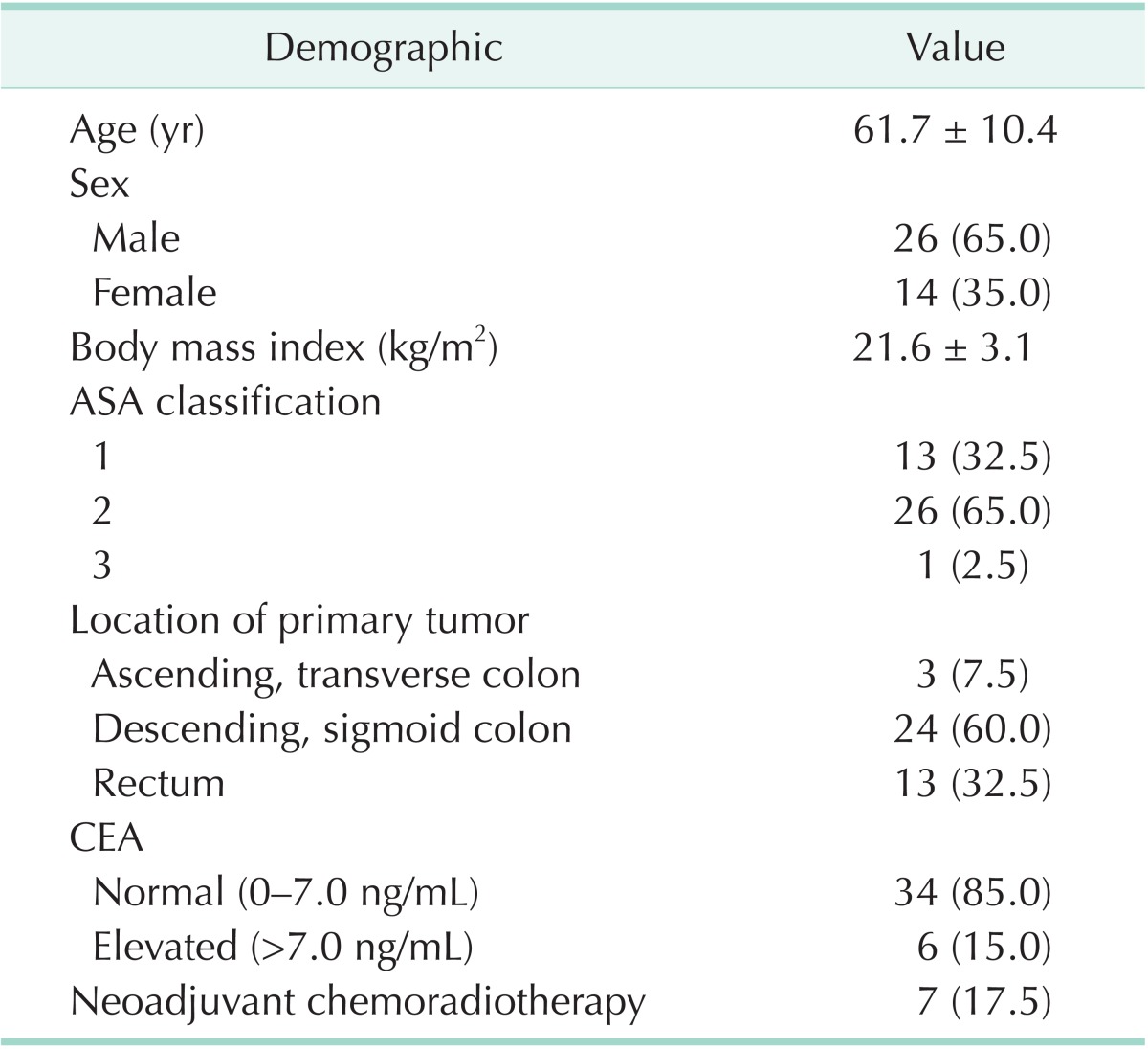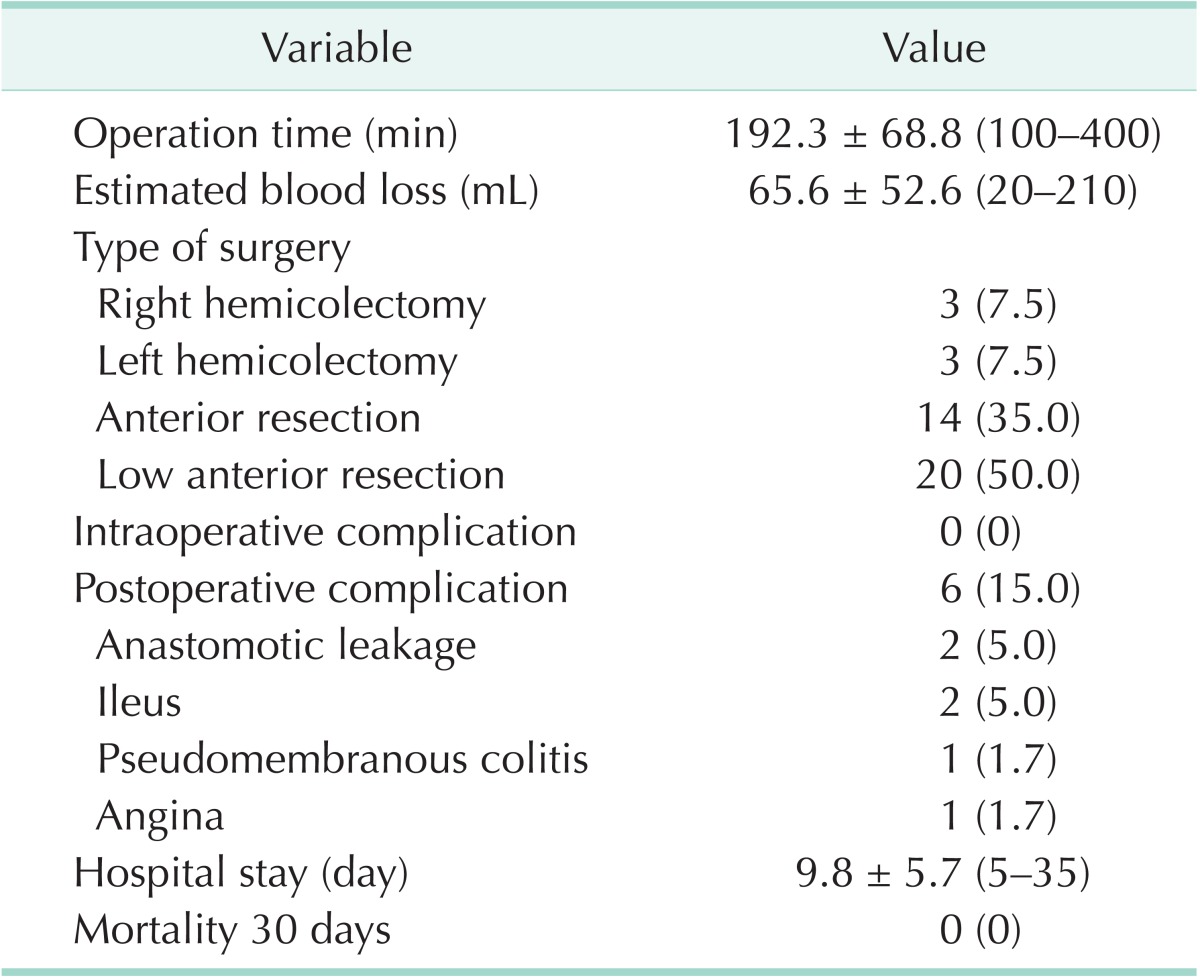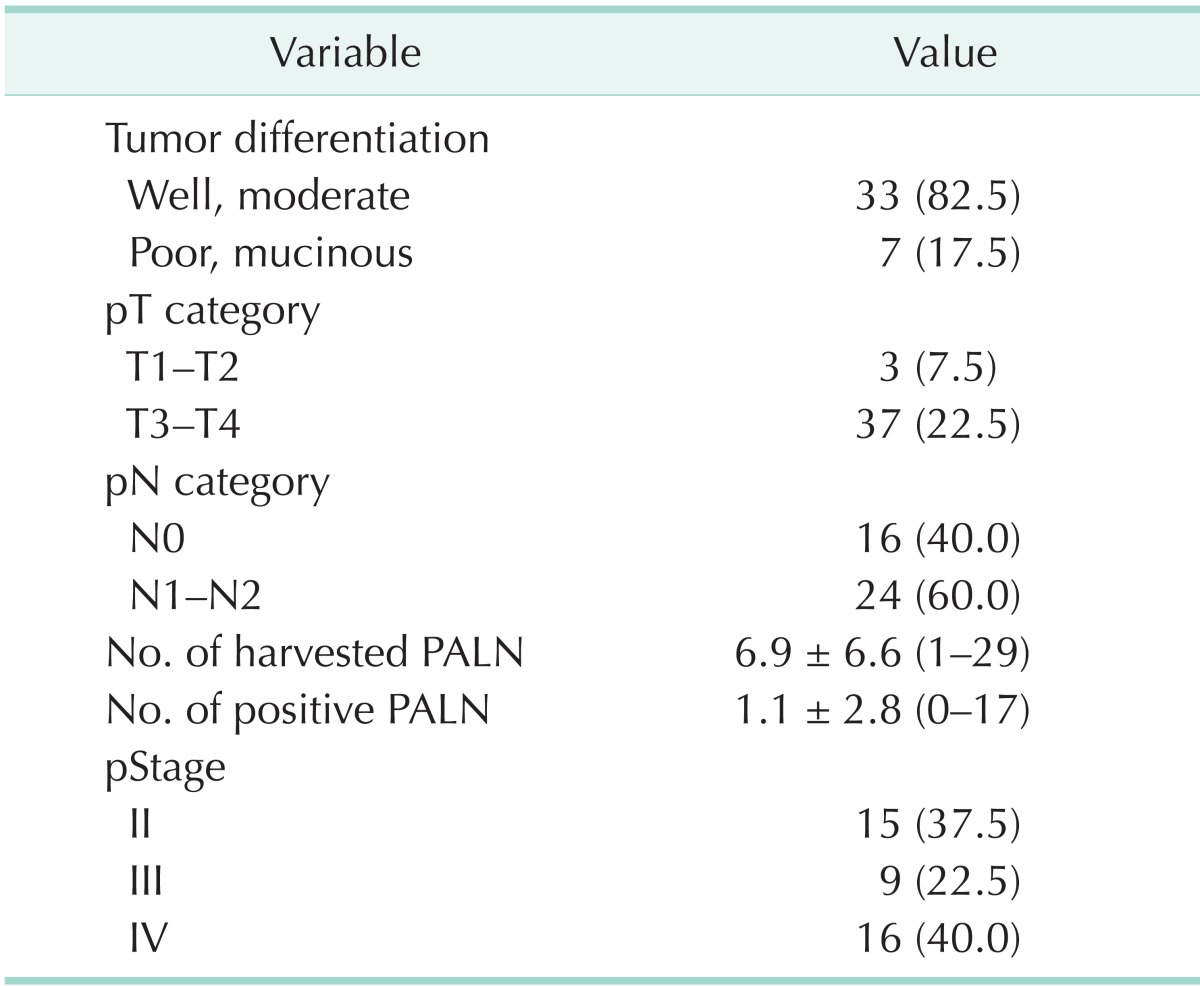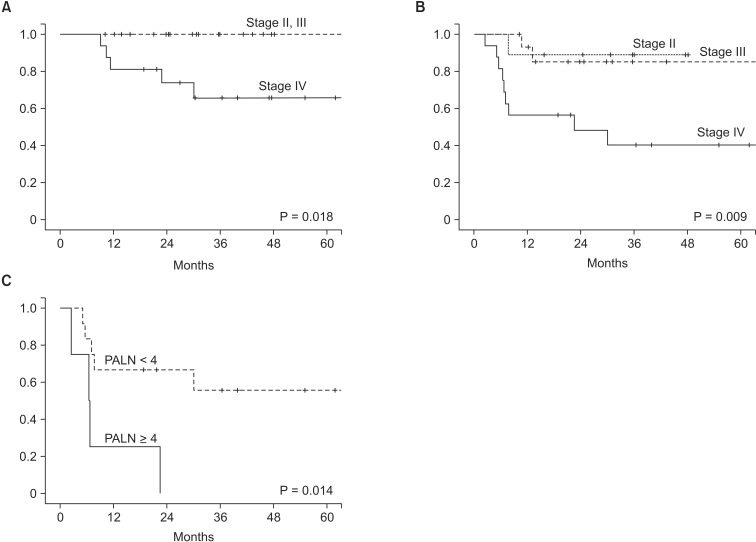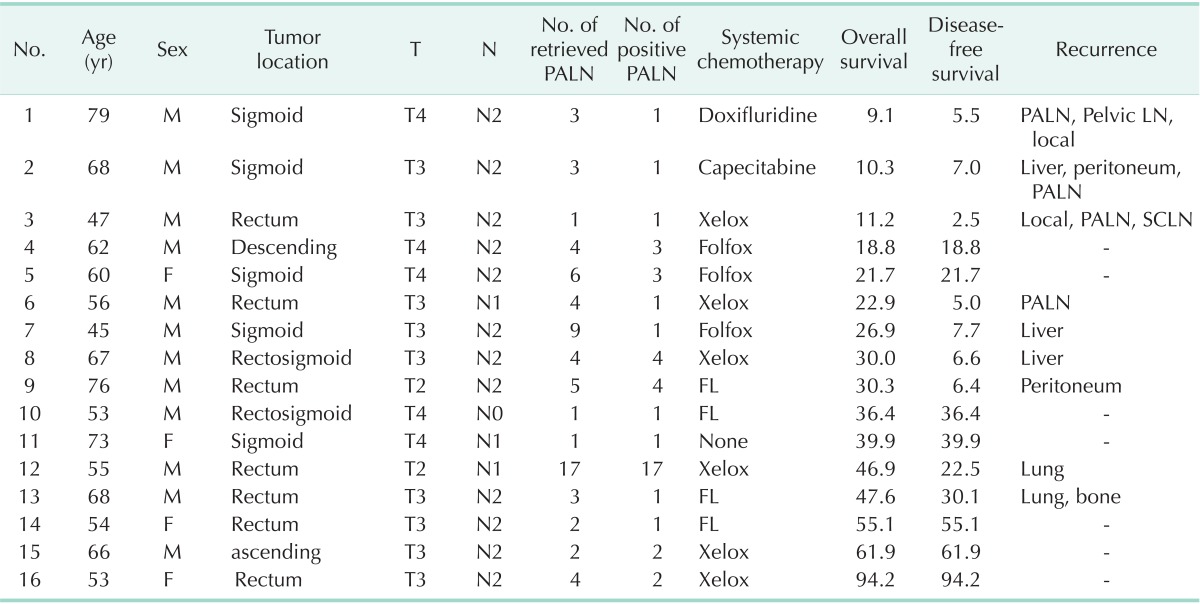Abstract
Purpose
Treatment of patients with para-aortic lymph node metastasis from colorectal cancer is controversial. The goal of this study was to investigate the technical feasibility of laparoscopic intrarenal para-aortic lymph node dissection in patients with colorectal cancer and clinically suspected para-aortic lymph node dissection.
Methods
The inclusion criteria for the laparoscopic approach were patients with infrarenal para-aortic lymph node metastasis from colorectal cancer. Patients who had any other distant metastatic lesion or metachronous para-aortic lymph node metastasis were excluded from this study. Perioperative outcomes and survival outcomes were analyzed.
Results
Between November 2004 and October 2013, 40 patients underwent laparoscopic para-aortic lymph node dissection. The mean operating time was 192.3 ± 68.8 minutes (range, 100-400 minutes) and the mean estimated blood loss was 65.6 ± 52.6 mL (range, 20-210 mL). No patient required open conversion. The postoperative complication rate was 15.0%. Sixteen patients (40.0%) had pathologically positive lymph nodes. In patients with metastatic para-aortic lymph nodes, the 3-year overall survival rate and disease-free survival rate were 65.7% and 40.2%, respectively.
Conclusion
The results of our study suggest that a laparoscopic approach for patients with colorectal cancer with metastatic para-aortic lymph nodes can be a reasonable option for selected patients.
Keywords: Colorectal neoplasms, Neoplasm metastasis, Lymph nodes, Lymph node excision, Laparoscopy
INTRODUCTION
Laparoscopic surgery for colorectal cancer has been accepted as the standard surgical treatment for colorectal cancer and benefits postoperative recovery, and oncologic safety was confirmed in randomized controlled trials [1,2]. Recently, many surgeons, including those in our institution, have used the laparoscopic approach for more complex procedures in patients with colorectal cancer, such as intersphincteric resection of very low rectal cancer and pelvic lymph node dissection in advanced rectal cancer [3,4,5,6].
Approximately 20% of patients present with metastases at initial diagnosis and almost 50% of patients with colorectal cancer will develop metastases, contributing to the high mortality rates reported for colorectal cancer [7,8,9]. While management of metastatic colorectal cancer has long been based on systemic chemotherapy, selected patients can be cured by surgical resection of isolated or multiple metastatic lesions. When radical resection is technically possible, patients who undergo curative resection of distant metastases regardless of the site have longer survival than those who do not [10]. Compared with liver and lung metastasis, management of para-aortic lymph nodal metastasis from colorectal cancer remains controversial. When only the isolated form of distant metastasis was reviewed, the isolated form of distant lymph node metastasis (mediastinal, intra-abdominal, or pelvic lymphadenopathy) was reported to be 8% [11]. The reported incidence of isolated PALN metastasis is 1%-2% [12].
Recently, several studies have suggested that surgery for PALN metastasis is a potentially curative treatment with acceptable postoperative morbidity and can achieve long-term overall survival (OS) in selected patients [13,14]. More specifically, Choi et al. [13] reported that surgical resection appears to increase the OS of patients with isolated PALN metastasis. Because of the low incidence of patients with PALN metastasis, the technical and oncological feasibility of the laparoscopic approach for these patients is not well known. For this reason, our institution aimed to reveal the technical feasibility and oncological outcomes of laparoscopic PALN dissection in patients with primary colorectal cancer and clinically suspected PALN.
METHODS
From November 2004 to October 2013, 2743 patients underwent laparoscopic resection of primary colorectal cancer with curative intent at Kyungpook National University Medical Center. Patients who underwent laparoscopic para-aortic lymph node (PALN) dissection in addition to resection of primary colorectal cancer were eligible for this study. Patients were excluded from this study if there was other organ metastasis (e.g., liver, lung, and peritoneum metastasis). All patients had given their written informed consent. The protocol for this study was approved by our ethics committee.
The eligible criteria for laparoscopic PALN dissection combined with resection of primary colorectal cancer included: (1) pathological diagnosis of colorectal cancer; (2) clinically suspected PALN on the preoperative radiologic studies, abdomen-pelvis CT (short diameter > 8 mm, irregular margin or central necrosis) and/or PET scan (positive fluorodeoxyglucose uptake); and (3) suspected PALN metastasis below the renal veins amenable to potentially complete resection. Exclusion criteria were as follows: suprarenal or retroaortic lymph node metastasis, metastatic lymph node invading to a major vessel, extra-abdominal lymph node metastasis (e.g., subclavicular lymph node), palliative surgery, and Eastern Cooperative Oncology Group performance status >2.
Surgical procedures
All operations were performed by two surgeons (G.S.C. and J.S.P.) according to institutional surgical protocols. Laparoscopic procedures were usually performed using one 10-mm camera port at the umbilicus and three or four 5-mm ports at each abdominal quadrant. The primary colorectal lesion was removed with regional lymph nodes and adequate resection margins. After identification of ureter and gonadal vessels, PALN dissection began from the aortic or common iliac bifurcation and proceeded upward to the lower border of the renal vessels and downward to the common iliac arteries. The extent of PALN dissection was dependent on the extent of suspected PALN. The para-aortic, precaval, or aortocaval lymph nodes were dissected laterally off the anterior surface of psoas muscle, inferior vena cava, and aorta (Fig. 1). When PALN metastasis was continued from the regional mesenteric lymph node, en block resection of regional lymph node and PALN was performed. An ultrasonic energy device (Harmonic Scalpel, Ethicon Endo-Surgery, Cincinnati, OH, USA) was mainly used to dissect PALN, and endobag was used when the dissected PALN was removed. Bowel reconstruction, colorectal or colocolic anastomosis, was performed after removal of specimen. At the end of surgery, estimated blood loss was based on the surgical sponge usage and weight, and by intraoperative suction.
Fig. 1. Final operative finding of laparoscopic resection and paraaortic lymph node dissection (66-year-old male patient with pathologically positive paraaortic lymph nodes).
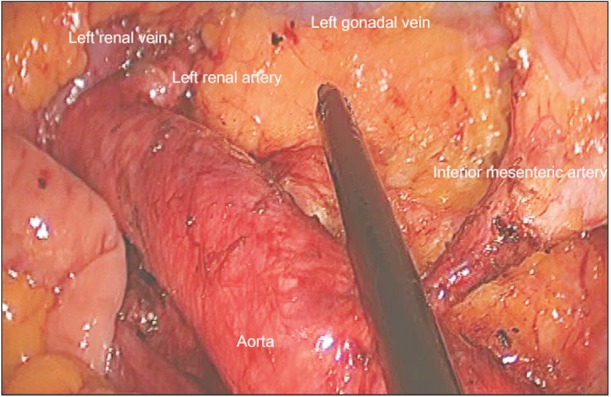
Postoperative chemotherapy and follow-up
Operative morbidity was defined as any complication that occurred within 30 days after operation. The following findings were considered to constitute anastomotic leaks: peritonitis, feculent substances in the pelvic drain, clinical dehiscence by rectal examination, or perianastomotic abscess on radiological imaging. Postoperative ileus was defined as no return of bowel function within 7 postsurgical days.
None of the patients received neoadjuvant chemotherapy for PALN metastasis. When a patient was tolerant, 5-fluorouracil or capecitabine-based systemic chemotherapy (with or without oxaliplatin or irinotecan) was administered to patients with stage III or IV tumors. All patients were followed up for at least 5 years or until death. Follow-up evaluation included physical examination, measurement of serum tumor markers levels, abdomen-pelvis CT, and chest CT.
Statistical analysis
The last follow-up was on May 1, 2015. Categorical variables were described in terms of frequencies and percentages, and continuous variables were described by mean value and standard deviation or median value and range. Survival curves were generated using the Kaplan-Meier method, and the log rank statistic was used for comparison. OS was calculated from the day of surgery to the date of the latest follow-up visit or the date of death due to any cause. The time between surgery and the date of the latest follow-up visit or the date of the first recurrence were used to calculate the follow-up time for recurrence-free survival. P-values < 0.05 were considered statistically significant. All statistical analyses were performed using the SPSS ver. 17.0 (SPSS Inc., Chicago, IL, USA).
RESULTS
A total of 46 patients underwent laparoscopic colorectal cancer resection and PALN dissection during the study period. Six of these patients were excluded because of metastasis to other distant organs. In total, 40 patients were included in this study. Patient clinicopathological characteristics are summarized in Table 1. The mean age of enrolled patients was 61.7 ± 10.4 years and 65.0% of all patients were male. Overall, 27 patients (65.7%) had colon cancer and 13 patients (32.5%) had rectal cancer. Seven of thirteen patients with rectal cancer received neoadjuvant radiochemotherapy, while none of the patients received neoadjuvant systemic chemotherapy for PALN metastasis. Preoperative CEA was elevated in six patients (15.0%), including two of nine patients (22.2%) with stage III tumor, and two of 16 patients (12.5%) with stage IV tumor.
Table 1. Patient demographics (n = 40).
Values are presented as mean ± standard deviation or number (%).
ASA, American Society of Anesthesiologists.
Operative outcomes are summarized in Table 2. The mean operating time was 192.3 ± 68.8 minutes (range, 100-400 minutes) and the median estimated blood loss was 65.6 ± 52.6 mL (range, 20-210 mL). No patient required open conversion and no patient suffered from PALN dissection-related intraoperative complications. A postoperative complication occurred in six patients (15.0%), of whom two patients suffered from anastomotic leakage and underwent reoperation. Two patients had ileus, one patient had pseudomembranous colitis, and one patient had angina pectoris. However, there were no postoperative complications related to PALN dissection such as lymphocele or chylous ascites. There was no 30-day mortality.
Table 2. Operative outcomes (n = 40).
Values are presented as mean ± standard deviation (range) or number (%).
In the pathologic reports, final stages were II in 15 patients (37.5%), III in 9 patients (22.5%), and IV in 16 patients (40.0%; Table 3). The mean number of retrieved PALN was 6.9 ± 6.6 (range, 1-29) and the mean number of positive PALN was 1.1 ± 2.8 (range, 0-17). In 16 patients with metastatic PALN, the mean number of retrieved and positive PALN were 4.3 ± 3.9 (range, 1-17) and 2.8 ± 3.9 (range, 1-17), respectively. After surgical resection, all patients with stage III tumors and 15 patients (93.8%) with stage IV tumors received adjuvant systemic chemotherapy.
Table 3. Pathologic characteristics (n = 40).
Values are presented as number (%) or mean ± standard deviation (range).
PALN, para-aortic lymph node.
The median follow-up was 31.0 months (range, 9.1-103.1 months). The OS and disease-free survival curves were significantly different according to tumor stage (P = 0.018 and P = 0.009, respectively). The 3-year OS rates were 100% in patients with stages II and III tumors, and 65.7% in patients with stage IV (Fig. 2A). The 3-year disease-free survival rates were 88.9%, 85.7%, and 40.2% in patients with stage II, stage III, and stage IV tumors, respectively (Fig. 2B). The 3-year disease-free survival rate in patients with metastatic PALN was significantly different according to the number of metastatic PALN (PALN < 4 vs. ≥4: 55.6% vs. 0.0%, P = 0.014) (Fig. 2C). No other factor was associated with disease-free survival or OS.
Fig. 2. Overall survival (A) and disease-free survival (B) of 40 patients according to tumor stage. (C) Disease-free survival of 16 patients with stage IV tumors (para-aortic lymph node, PALN) according to the number of metastatic PALN.
The characteristics of 16 patients who had metastatic PALN are shown in Table 4. Nine patients had disease recurrence during follow-up; including five with recurrences on organs other than PALNs, three with both PALN recurrences and other distant metastases, and one with a PALN only recurrence. Five patients died of disease progression. Seven patients were alive without disease recurrence at the end of this study.
Table 4. Clinicopathological characteristic and follow-up data of patients with metastatic PALN.
PALN, para-aortic lymph node; SCLN, supraclavicular lymph node; Xelox, capecitabine with oxaliplatin; Folfox, oxaliplatin with fluorouracil; FL, fluorouracil with leucovorin.
DISCUSSION
Liver or lung metastasis resection is widely accepted as the standard of care and 5-year survival rates are more than 50% following surgery [10]. For retroperitoneal lymph node metastasis, however, there have only been a few studies investigating surgical resection of metastatic lymph nodes and there is no consensus on therapeutic strategy. Moreover, there is limited literature regarding a laparoscopic approach for PALN dissection. In the current study, we performed laparoscopic surgical resection of primary colorectal cancer and clinically suspected PALN. Our study showed that the laparoscopic approach was technically feasible to dissect PALN without serious complications and about 40% of patients had positive PALN in our cohort.
A few studies evaluating surgical resection of colorectal cancer PALN have been reported. For instance, Shibata et al. [15] analyzed 20 patients who received surgical resection of recurrent retroperitoneal lymph nodes with curative intent. They reported 5 cases (25%) of postoperative complications, including abscess, phlebitis, pneumonia, small bowel obstruction, and bladder leakage and 1 case (5%) of 30-day mortality. Choi et al. [13] performed surgical resection of synchronous metastatic infrarenal PALNs in addition to primary colorectal cancer in 24 patients. They reported 25% postoperative complications and no operative mortalities. Min et al. [14] performed surgical resection of recurrent intrarenal PALNs in six cases and they reported operative morbidity of 33% and no operative mortalities. Regarding laparoscopoic resection of PALN, there have been 3 studies, which were reported by the same institution in Taiwan [16,17,18]. Operative complication rates ranged between 20.5% and 29.4%. Compared with standard laparoscopic colorectal cancer resection, additional PALN dissection can be safely performed without additional surgical complications. The operative outcomes of our study were comparable with the previous studies investigating both open and laparoscopic PALN dissection. Because of our strict selection criteria for the laparoscopic approach for PALN dissection, open conversion was not required in any case and no patient suffered from PALN dissection-related perioperative complications.
In our cohort, the rate of pathologically positive PALN was 40.0% in all 40 patients whose diagnosis was based on both preoperative image studies and intraoperative findings. However, none of the patients who appeared intraoperatively to have visibly enlarged PALN but had no abnormal preoperative image findings had any positive PALN; none of them experienced distant lymph node recurrence and these patients were not included in our analysis. Our institutional findings may not be representative of all colorectal cancer patients. However, the laparoscopic approach can be a technically safe method to explore suspicious PALN to define accurate tumor stage.
We report a 3-year OS of 65.7% and 3-year disease-free survival of 40.2% in patients with metastatic PALN after surgical resection, which are consistent with results in previous studies. Various combinations of treatments, including surgical resection, radiotherapy, or systemic chemotherapy have been used according to institutional strategies. Most studies exploring the outcomes of surgical resection included patients with isolated PALN metastasis excluding patients with other distant metastasis. The 3-year OS rate was reported between 59.4% and 81%, and 3-year disease-free survival rate ranged from 26% to 57.2% [11,13,15,19].
Two studies have shown oncological outcomes of patients with retroperitoneal lymph node recurrence who were treated by chemoradiotherapy: the 3-year OS was 64.7% and 3-year disease-free survival was 34.1% [20]. Similarly, 2-year OS rate of 69.6% and progression-free survival rates of 37.5% were reported by Lee et al. [21]. As shown in our study cohort, not all patients with suspicious findings on preoperative image studies have pathologically positive lymph nodes. The advantage of surgical resection over radiotherapy is that it can provide confirmative pathologic information of suspicious lymph nodes on imaging studies. However, surgical resection is not always feasible, especially when metastatic lymph nodes invade a vital vessel or organ or when patient performance status cannot tolerate a complicated surgery. Because of the inherently small number of patients with this specific disease condition and the rarity of studies, we cannot conclude which treatment option, surgery or radiotherapy, is more beneficial to eradicate metastasized PALN based on the currently available literature. However, local treatment using surgical resection or radiotherapy can be incorporated into the multidisciplinary treatment approach for these patients.
After treating patients with isolated PALN metastasis, the recurrence rate at the PALN dissection site was as high as the rate in other distant organ metastasis. In the current study, 4 of 9 (44.4%) recurrent patients had infrarenal or suprarenal PALN metastasis. Because the outcomes of our patients could not be compared with outcomes of patients who underwent open surgery, the results of this study do not allow a determination of whether recurrence on the surgical field of PALN dissection was mainly due to the laparoscopic procedure. However, rate of recurrence on the PALN in this study was comparable to the rates in previous studies. Following open dissection of PALN metastases, the most frequent site of recurrence was the PALN, observed in 30%-73% of all treated patients [12,13,15,19]. Our experience and the results of previous studies suggest that this recurrence pattern may be due to the intrinsic features of PALN dissection and advanced tumor stage. Unlike regional (pericolic) lymph nodes, the procedural extent of PALN dissection has not been standardized. Moreover, as the extent of PALN dissection in this study was limited to the suspicious area, remnant lymph nodes may harbor microscopic cancer cells. Advanced visual navigation methods, such as fluorescent imaging techniques, may help a surgeon in complete removal. Our results confirm the findings of previous studies, that patients with PALN metastasis have shown poorer survival outcomes than patients with stage III tumors [15,19]. These findings suggest that surgical resection of PALN metastasis should be followed by systemic chemotherapy to control microscopically disseminated cancer cells.
Our findings should be considered within the context of the limitations of a retrospective study. Although we found that disease-free survival of patients with metastatic PALN was associated with the number of positive PALN, further analysis for prognostic factors was limited by the small number of patients. We have extensive experience with laparoscopic surgery for patients with both primary and recurrent tumor. Nevertheless, we performed this technique on selected patients with highly specific criteria and the number of enrolled patients was small. Further studies are necessary to identify the most relevant candidates and oncological implications of this surgical approach.
In conclusion, our results suggest that laparoscopic PALN dissection in addition to resection of primary colorectal cancer is technically feasible and safe in patients with suspicious infrarenal PALNs. The laparoscopic approach can identify patients with pathologically positive PALN. In these patients, metastasized PALN might be locally controlled by laparoscopic resection. In the future, additional studies involving larger patient numbers, long-term follow-up periods, and quality-of-life measurements are warranted to validate our results.
ACKNOWLEDGEMENTS
This research was supported by Handok Jeseok Foundation, 2014.
Footnotes
CONFLICTS OF INTEREST: No potential conflict of interest relevant to this article was reported.
References
- 1.Fleshman J, Sargent DJ, Green E, Anvari M, Stryker SJ, Beart RW, Jr, et al. Laparoscopic colectomy for cancer is not inferior to open surgery based on 5-year data from the COST Study Group trial. Ann Surg. 2007;246:655–662. doi: 10.1097/SLA.0b013e318155a762. [DOI] [PubMed] [Google Scholar]
- 2.Colon Cancer Laparoscopic or Open Resection Study Group. Buunen M, Veldkamp R, Hop WC, Kuhry E, Jeekel J, et al. Survival after laparoscopic surgery versus open surgery for colon cancer: long-term outcome of a randomised clinical trial. Lancet Oncol. 2009;10:44–52. doi: 10.1016/S1470-2045(08)70310-3. [DOI] [PubMed] [Google Scholar]
- 3.Marks J, Mizrahi B, Dalane S, Nweze I, Marks G. Laparoscopic transanal abdominal transanal resection with sphincter preservation for rectal cancer in the distal 3 cm of the rectum after neoadjuvant therapy. Surg Endosc. 2010;24:2700–2707. doi: 10.1007/s00464-010-1028-8. [DOI] [PubMed] [Google Scholar]
- 4.Park JS, Choi GS, Jun SH, Hasegawa S, Sakai Y. Laparoscopic versus open intersphincteric resection and coloanal anastomosis for low rectal cancer: intermediateterm oncologic outcomes. Ann Surg. 2011;254:941–946. doi: 10.1097/SLA.0b013e318236c448. [DOI] [PubMed] [Google Scholar]
- 5.Park JS, Choi GS, Lim KH, Jang YS, Kim HJ, Park SY, et al. Laparoscopic extended lateral pelvic node dissection following total mesorectal excision for advanced rectal cancer: initial clinical experience. Surg Endosc. 2011;25:3322–3329. doi: 10.1007/s00464-011-1719-9. [DOI] [PubMed] [Google Scholar]
- 6.Liang JT. Technical feasibility of laparoscopic lateral pelvic lymph node dissection for patients with low rectal cancer after concurrent chemoradiation therapy. Ann Surg Oncol. 2011;18:153–159. doi: 10.1245/s10434-010-1238-2. [DOI] [PubMed] [Google Scholar]
- 7.Edge SB, Byrd DR, Compton CC, Fritz AG, Greene FL, Trotti A, editors. AJCC cancer staging manual. 7th ed. New York: Springer; 2010. [Google Scholar]
- 8.Howlader N, Noone AM, Krapcho M, Garshell J, Miller D, Altekruse SF, et al. SEER Cancer Statistics Review, 1975-2012 [Internet] Bethesda (MD): National Cancer Institute; 2014. [cited 2015 Apr 30]. Available from: http://seer.cancer.gov/csr/1975_2012/ [Google Scholar]
- 9.Jung KW, Won YJ, Kong HJ, Oh CM, Cho H, Lee DH, et al. Cancer statistics in Korea: incidence, mortality, survival, and prevalence in 2012. Cancer Res Treat. 2015;47:127–141. doi: 10.4143/crt.2015.060. [DOI] [PMC free article] [PubMed] [Google Scholar]
- 10.Mahmoud N, Bullard Dunn K. Metastasectomy for stage IV colorectal cancer. Dis Colon Rectum. 2010;53:1080–1092. doi: 10.1007/DCR.0b013e3181dcadbc. [DOI] [PubMed] [Google Scholar]
- 11.Khattak MA, Martin HL, Beeke C, Price T, Carruthers S, Kim S, et al. Survival differences in patients with metastatic colorectal cancer and with single site metastatic disease at initial presentation: results from South Australian clinical registry for advanced colorectal cancer. Clin Colorectal Cancer. 2012;11:247–254. doi: 10.1016/j.clcc.2012.06.004. [DOI] [PubMed] [Google Scholar]
- 12.Gagniere J, Dupre A, Chabaud S, Peyrat P, Meeus P, Rivoire M. Retroperitoneal nodal metastases from colorectal cancer: curable metastases with radical retroperitoneal lymphadenectomy in selected patients. Eur J Surg Oncol. 2015;41:731–737. doi: 10.1016/j.ejso.2015.03.229. [DOI] [PubMed] [Google Scholar]
- 13.Choi PW, Kim HC, Kim AY, Jung SH, Yu CS, Kim JC. Extensive lymphadenectomy in colorectal cancer with isolated paraaortic lymph node metastasis below the level of renal vessels. J Surg Oncol. 2010;101:66–71. doi: 10.1002/jso.21421. [DOI] [PubMed] [Google Scholar]
- 14.Min BS, Kim NK, Sohn SK, Cho CH, Lee KY, Baik SH. Isolated paraaortic lymphnode recurrence after the curative resection of colorectal carcinoma. J Surg Oncol. 2008;97:136–140. doi: 10.1002/jso.20926. [DOI] [PubMed] [Google Scholar]
- 15.Shibata D, Paty PB, Guillem JG, Wong WD, Cohen AM. Surgical management of isolated retroperitoneal recurrences of colorectal carcinoma. Dis Colon Rectum. 2002;45:795–801. doi: 10.1007/s10350-004-6300-3. [DOI] [PubMed] [Google Scholar]
- 16.Liang JT, Huang KC, Lai HS, Lee PH, Sun CT. Oncologic results of laparoscopic D3 lymphadenectomy for male sigmoid and upper rectal cancer with clinically positive lymph nodes. Ann Surg Oncol. 2007;14:1980–1990. doi: 10.1245/s10434-007-9368-x. [DOI] [PubMed] [Google Scholar]
- 17.Liang JT. Surgical techniques of laparoscopic peritonectomy plus paraaortic lymph node dissection for the treatment of patients with positive lymph node metastasis and peritoneal seeding from rectosigmoid cancer. Surg Endosc. 2012;26:2383–2387. doi: 10.1007/s00464-012-2163-1. [DOI] [PubMed] [Google Scholar]
- 18.Liang JT, Lai HS, Wu CT, Huang KC, Lee PH, Shun CT. Laparoscopic prophylactic oophorectomy plus N3 lymphadenectomy for advanced rectosigmoid cancer. Ann Surg Oncol. 2007;14:1991–1999. doi: 10.1245/s10434-007-9346-3. [DOI] [PubMed] [Google Scholar]
- 19.Dumont F, Kothodinis K, Goere D, Honore C, Dartigues P, Boige V, et al. Central retroperitoneal recurrences from colorectal cancer: are lymph node and locoregional recurrences the same disease? Eur J Surg Oncol. 2012;38:611–616. doi: 10.1016/j.ejso.2012.04.003. [DOI] [PubMed] [Google Scholar]
- 20.Yeo SG, Kim DY, Kim TH, Jung KH, Hong YS, Kim SY, et al. Curative chemoradiotherapy for isolated retroperitoneal lymph node recurrence of colorectal cancer. Radiother Oncol. 2010;97:307–311. doi: 10.1016/j.radonc.2010.05.021. [DOI] [PubMed] [Google Scholar]
- 21.Lee J, Chang JS, Shin SJ, Lim JS, Keum KC, Kim NK, et al. Incorporation of radiotherapy in the multidisciplinary treatment of isolated retroperitoneal lymph node recurrence from colorectal cancer. Ann Surg Oncol. 2015;22:1520–1526. doi: 10.1245/s10434-014-4363-5. [DOI] [PubMed] [Google Scholar]



